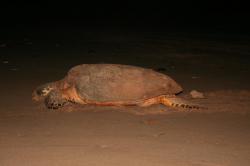New Sea Turtle Study Confirms Significant Nesting at James Price Point
The findings from the recent sea turtle study were released yesterday, casting further doubts over the scientific integrity of the W. Australia Government’s environmental impact assessment for the James Price Point gas hub.
SeaTurtles.org reported the nesting of the sea turtle in December and posted a video of the unusual sea turtle with the details here.
The peer-reviewed study into marine turtle nesting in the James Price Point area led by University of Melbourne marine biologist Malcolm Lindsay found 14 turtle nests and 38 false crawls over the 2011/2012 nesting season, including the first ever recorded hawksbill hybrid in Australia.
The vast majority of nesting activity was concentrated in a 6 kilometer strip of coastline directly adjacent to the proposed natural gas refinery. As a consequence, the nesting habitat will be heavily impacted by the proposed gas refinery and associated marine facilities and pipeline.
In contrast, the marine turtle nesting study commissioned for the Western Australian Department of State Development on behalf of the joint venture partners Woodside Petroleum, Chevron, Shell, BP and BHP Billition found only one ‘old’ nest and three false crawls. The authors of the independent report claim that the government’s study was inadequate and poorly designed. The government study surveyed only 12 percent of the coastline most threatened by the precinct, overlooking the significant 6km strip of important nesting habitat.
One of the author’s, marine biologist Madeline Goddard commented: “We understand that these projects require difficult weighing up of impacts to environment and aboriginal culture versus perceived jobs and royalties, we would hope that those difficult judgements would be well informed. That is not occurring with the science involved here.”
Traditional Goolarabooloo elder, Phillip Roe, commented yesterday: “[W.A. Premier] Barnett can try to paint James Price Point as insignificant, but we know that there are dinosaur footprints, bilbies, turtle nests, whales, songlines, registered sacred sites all here, this is a sacred site worth protecting for all Australians, black or white.”
“The hybrid hawksbill is exciting news, but even more so is the science that supports local knowledge that James Price Point is important to sea turtles,” said Teri Shore, Program Director at SeaTurtles.org in California. Shore has provided expert comments and testimony on the environmental analysis of the Browse Basin natural gas projects. She has traveled to the Kimberley to help monitor flatback nesting beaches and lend support to local activists striving to halt the fossil fuel expansion.
All three species found in the study are nationally listed as threatened and any nesting population is considered significant by the Western Australian Environmental Protection Authority due to the heavy impacts that have occurred and the international significance of Northern Australia’s turtle populations.
The new sea turtle findings add additional scientific doubts to the integrity of the Strategic Assessment Report for the Browse Basin Gas Refinery proposed for James Price Point.
In July, a Queensland palaeontologist documented dinosaur trackways of international significance at James Price Point that were overlooked by the government studies.
Another significant oversight was revealed in August, when an ecological survey found a breeding population of the nationally threatened Bilby at the site.
The cetacean research group of Macquarie University recently released a damning public submission on the Strategic Assessment Report, remarking that they had “little confidence in the scientific integrity of the report and … conclusions reached within.”
Report from Turtle Island Restoration Network. Learn more at SeaTurtles.org

